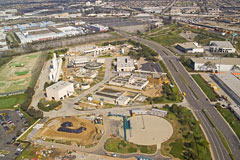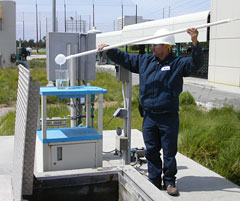Sustainable Water Infrastructure Contacts
Pacific Southwest, Region 9
Serving: Arizona, California, Hawaii, Nevada, Pacific Islands, Tribal Nations
Water & Energy Efficiency in Water and Wastewater Facilities
| Sustainable Water Infrastructure Quick Finder | ||||
|---|---|---|---|---|
| FundingGreen Jobs in the Water SectorLow Impact Development | Waste To Biogas Mapping ToolWater Conservation/EfficiencyWater-Energy Connection | Water Loss ControlWhy Sustainability? | ||
Orange County Wins the Water Efficiency Leaders Award

The Orange County Water District has won the US EPA’s Water Efficiency Leader Award, which recognizes organizations and individuals who demonstrate outstanding leadership and innovation in water efficiency. Winners were chosen by a panel of national water experts based on three criteria: leadership, innovation, and water saved. The awards are made to help foster a national ethic of water efficiency, and to inspire, motivate, and recognize efforts to improve water efficiency.
Orange County Water District was recognized for its success in wastewater purification for groundwater replenishment. Their triple purification process of microfiltration, reverse osmosis, and ultraviolet and hydrogen peroxide treatment produces water able to meet, and in some cases, exceed state and federal drinking water standards. Their acclaimed advanced treatment system coupled with a successful public education campaign has enabled the County to send highly-treated wastewater back into the groundwater supply to serve as drinking water to 500,000 people. The project is highlighted in detail on our water recycling website and also featured on a special Public Broadcast TV Station documentary.
Other Water Recycling Projects in the Pacific Southwest
Many water districts across Region 9 are also recycling water. Carson, California’s West Basin Municipal Water District, for example, has been making five types of “designer” waters for use by refineries, seawater barriers, several city and industrial customers, as well as parks, golf courses and schools since 1990. West Basin’s “designer” waters are customized to meet customer’s unique needs and have been used as irrigation water, high pressure boiler feed water, low pressure feed water, purified seawater barrier water and cooling tower water.
Significant quantities of water—primarily for processing and cooling— are needed to produce fuel. Refineries use about 1 to 2.5 gallons of water for every gallon of product, meaning that the United States, which refines nearly 800 million gallons of petroleum products per day, consumes about 1 to 2 billion gallons of water each day to produce fuel (USDOE, 2006).
Last year, West Basin’s refinery customers—Chevron, Exxon, and British Petroleum (BP)—used a combined total of 17,500 acre feet (or nearly six billion gallons) of water for cooling towers and high and low pressure boiler feed water. Chevron uses 100% recycled water to meet its process and cooling water needs, Exxon uses 64%, and BP will use 90% recycled water by 2013.
According to West Basin, converting one refinery to recycled water saves enough water to serve a small city. Using recycled water at southern California refineries also saves energy. Recycling water, rather than importing water from northern California, saves on average 1,700 kilowatt hours of electricity per acre foot.
West Basin is planning to double its water recycling efforts from approximately 30 million gallons a day to about 70 million gallons a day. It also plans on expanding its recycled “purple” piping system from its current 70 miles in length to about 130 miles by 2020.
In northern California, the City of Santa Rosa’s Laguna treatment plant recycled and reused over 97%, or 6.4 billion gallons, of their wastewater in 2008: 4.3 billion gallons was sent to the Geysers Steam fields for production of green power; 2.0 billion gallons was reused for agricultural irrigation on crops ranging from pasture to award winning wine grapes, and 0.1 billion gallons was reused for urban irrigation.

Out of 6.6 billion gallons treated, only 190 million gallons (less than 3%) were discharged, and that discharge occurred during a 12 day period in February. The completion of the Geysers Recharge Project in 2004 was made possible by funding from the State Revolving Fund (SRF) loan program and some small grants from the Department of Energy, the California Energy Commission, and EPA. These impressive decreases in discharges resulted from significant water conservation efforts and inflow/infiltration reductions.
Out of 6.6 billion gallons treated, only 190 million gallons (less than 3%) were discharged, and that discharge occurred during a 12 day period in February. The completion of the Geysers Recharge Project in 2004 was made possible by funding from the State Revolving Fund (SRF) loan program and some small grants from the Department of Energy, the California Energy Commission, and EPA. These impressive decreases in discharges resulted from significant water conservation efforts and inflow/infiltration reductions.
To learn more about water recycling and water conservation, refer to Region 9’s Sustainable Water Infrastructure office. We provide technical support and financial resources to increase water and energy efficiency in water, wastewater, and stormwater infrastructure throughout Arizona, California, Hawaii, Nevada, the Pacific Islands, and Tribal Nations. On our website, you can learn about the various ways drinking water and wastewater facilities can save money, water and energy, and, by doing so, reduce greenhouse gas emissions.

